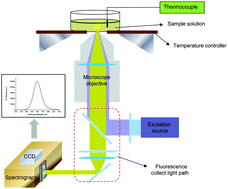Thermal sensing with CdTe/CdS/ZnS quantum dots in human umbilical vein endothelial cells
Abstract
An experimental methodology is presented to measure the temperature variation in cells with the usage of CdTe/CdS/ZnS core/shell/shell quantum dots as nanothermometers. The photoluminescence spectral shifts from the endocytosed quantum dots were measured and analyzed to show heat generation in the human umbilical vein endothelial cell following Ca2+ stress. Cytotoxicity evaluation has demonstrated the CdTe/CdS/ZnS QDs are biocompatible to cells. The measured data show that the thermal sensibility of the core/shell/shell nanocrystals has been calibrated and has a linear correlation of 0.16 nm °C−1 along with temperature variation. The photoluminescence spectral shift of QD uptake in the cell indicates a thermogenesis of 3.125 °C.



 Please wait while we load your content...
Please wait while we load your content...